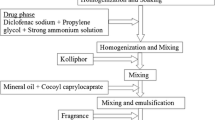Abstract
Erythromycin, an antibiotic commonly used topically in the treatment of acne, is unstable in solution. The stability is influenced by the pH and by the presence of water. The influence of the pH on the stability of erythromycin was investigated even with the use of dimethyl isosorbide as co-solvent instead of water. The addition of zinc was attempted to ameliorate erythromycin stability as suggested in the literature. To investigate these three factors and their interactions, an optimization technique was carried out consisting of a 23 factorial analysis and a rotative central composite design. The erythromycin solutions were analysed with an HPLC method. The pH and the concentration of dimethyl isosorbide had a significant influence on the stability of erythromycin but the addition of zinc was not a significant factor. Moreover, there was a significant interaction between the pH and dimethyl isosorbide.
Similar content being viewed by others
References
BurkeB, EadyEA, CunliffeWJ. Benzoyl peroxide versus topical erythromycin in the treatment of acne vulgaris. British Journal of Dermatology 1983;108:199–204.
AmerMM, TaklaKF. Studies on the stability of some pharmaceutical formulations, V-Stability of erythromycin. Bull Fac Pharm Cairo Univ 1978;15:325–9.
TsujiK and GoetzJF. High-performance chromatographic determination of erythromycin. Journal of Chromatography 1978;147:359–67.
ExnerJH, ComiteH, DahodS, PochiPE. Topical erythromycin/zinc effect on acne and sebum secretion. Current Therapeutic Research 1983;34:762–7.
BrisaertM, VanAckerT and Plaizier-VercammenJA. Onderzoek naar de chemische stabiliteit van erythromycine base in dermatologische lotions. Farmaceutisch Tijdschrift voor België 1994;71:2–5.
Leaflet n° 46-1E: Pharmaceuticals ‘Arlasolve’ DMI: dimethyl isosorbide, ICI-surfactants, Everberg, Belgium.
CachetTh, KibwageIO, RoetsE, HoogmartensJ. and VanderhaegheH. Optimization of the separation of erythromycin and related substances by high-performance liquid chromatography. Journal of Chromatography 1987;409:91–100.
CachetTh, Van denMooterG, HauchecorneR, VinckierC and HoogmartensJ. Decomposition kinetics of erythromycin A in acidic aqueous solutions. International Journal of Pharmaceutics 1989;55:59–65.
BoltonS. Pharmaceutical Statistics, Practical and Clinical Applications. 2nd edition revised and expanded. New York: M Dekker, 1990:258–78 and 421–51.
LiebermanH, RiegerM and BankerG. Pharmaceutical Dosage Forms: Disperse systems vol. 1. New York: M Dekker, 1988:427–44.
MorganE. Chemometrics: Experimental Design. New York John Wiley, 1991:118–121.
Author information
Authors and Affiliations
Rights and permissions
About this article
Cite this article
Brisaert, M., Heylen, M. & Plaizier-Vercammen, J. Investigation on the chemical stability of erythromycin in solutions using an optimization system. Pharm World Sci 18, 182–186 (1996). https://doi.org/10.1007/BF00820730
Issue Date:
DOI: https://doi.org/10.1007/BF00820730




